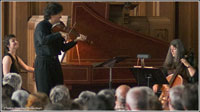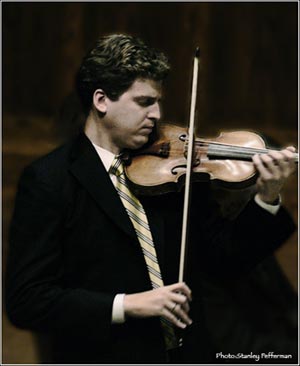 |
|
2004 Ottawa International Chamber Music Festival
|
| July 27, 2004 |
|
| Baroque Sonatas Report
You're at the lake in the Gatineaus, totally at peace, but thinking of going into busy, muggy, Ottawa to hear some chamber music, which, eventually, could be so good it would make you feel like you're back in the peace of the lake in the Gatineaus where you started. So, why go, if feelingwise you're already there? Because you live in the challenge, and IT'S LIVE MUSIC.
Ottawa. A river runs through it. A canal also runs through it and a major highway. Huge federal complexes to go around, and if you miss the right downtown turnoff at rush hour, no left turn one-way street restrictions can lead you over a bridge back to Hull or onto one of two expressways to Montreal in the blink of a yawn.
But.... When you arrive at the venue and find parking and enter the silence, the program of Baroque Sonatas for baroque violin, harpsichord and viola de gamba, take you right back to the peace of the lake in the Gatineaus.
|
| David Greenberg, Marie Bouchard, and Susan Napper play exquisitely with deep feeling through the program of Walter, Bach, and Moffat. Then the felictious program change brings out the vivacity and fun of a Scottish baroque suite including the sonata "The Virgin's Bower", by James Oswald, and "Hit Her on the Bum", a variation set from Robert Bremner that aroused the audience to a display of unrestrained enthusiasm. Right on. |
|
 |
|
| Portrait of the Artist as a Clown
Rotund and Jovial Jean Desmarais bounces onto the stage while the evening's MC is finishing his address with a request about refraining from flash photography and cell-phoning. Demarais sits at the keyboard, raises his hands to strike the opening notes, and a cell phone rings. The audience produces a collective gasp/groan and Demarais look incredulous. A blackclad staffperson makes her way to the stage with the offending cellphone and extends her arm to Desmarais:"It's for you!" "For me?" "Yes". He sits and talks for a while, then hands the phone back to the staffperson who exits. Desmarais fixes a round red clown nose over his own and proceeds to play Julius Fucik's Entry of the Gladiators.
Young and beautiful Lucille Chung and Alessio Bax follow with piano duets from Parade: Realist Ballet in one act by Eric Satie, the pieces having titles like Chinese Conjurer, Ragtime of the passenger steamer, Acrobat. Next, Demarais, sans fake nose, prances through Debussy's Mistral.
More clowning and a performance of the music from Stravinsky's Petrouchka is to follow after the intermission, but I have decided to sacrifice that and run down the street to hear Paul Brodie play his saxophone.
|
From Sacred to Jazz
Downtown Ottawa seems to have a church almost every two blocks in any direction, so I make it to the next venue for Paul Brodie's-"From Sacred to Jazz" before his intermission, in time to hear the most smooth and lovely alto saxophone in the world breathing out the mellifluous strains of Gabriel Faure´'s Pavane, opus 50. I'm back at the lake again and peaceful in spirit. A sacred moment, indeed.
After intermission, the Sacred gives way to Jazz. Duke Ellington told us long ago, "It don't mean a thing, if it ain't got that swing." The Jazz half of Brodie's program, with him on alto and Glen Montgomery on piano, was based on the music of Rudy Weidoeft who, Brodie told us, first figured out how to make a sax honk and squeak and laugh and meow. The pieces of Weidoeft that Brodie played had a ragtime bounce with titles like Sax-O-doodle, and Sax-O-Phun. Give me a break.
He did not swing: I did not get with it, despite hearing echoes of the virtuoso saxocroonings of Freddie Gardner that I liked fifty years ago. Seems like I've moved on, with the Duke. While the audience was loving the program, I slipped out and drove back to the lake.
|
|
|
|
July 28, 2004
|
| James Ehnes and his Stradivarius |
|
His touch is almost transparent. The sweet singing voice of the violin, rich with tenderness and the light-handed passion of a mother for her child arises like a dot in space, elongates into lines of melody bouyant and vivid as perfume which dissolves without a trace into the silence of the hall, swelling again, wave after wave of the thought of Brahms and Dvorak.
Like the current James Bond, whom he resembles, Ehnes's face and body betray barely a trace of expression as he takes care of his complex business with perfect precision, economy and ease. By contrast, his accompaniest on piano, Eduard Laurel, dark, angular, intense, electric, provides in his playing and animated gestures the bold chiaroscuro strokes of emphasis that enhance the drama of the recital.
The program of Suite for Violin and Piano, opus 10, by Christian Sinding; Sonata for Violin and Piano in D minor, opus 108 by Brahms; Sonatina for Violin and Piano in G major, opus 100, by Dvorak; Polonaise Brillante No. 2 in A major, opus 21, by Wieniawski, and Pablo de Sarasate's Introduction and Tarantella, opus 43, brought a thunderous response from the audience which demanded and received two encores.
|
|

James Ehnes |
|
|
|
|
Report and photographs by Stanley Fefferman
|
| We welcome your comments and feedback – reporters@thelivemusicreport.com |
|
|



